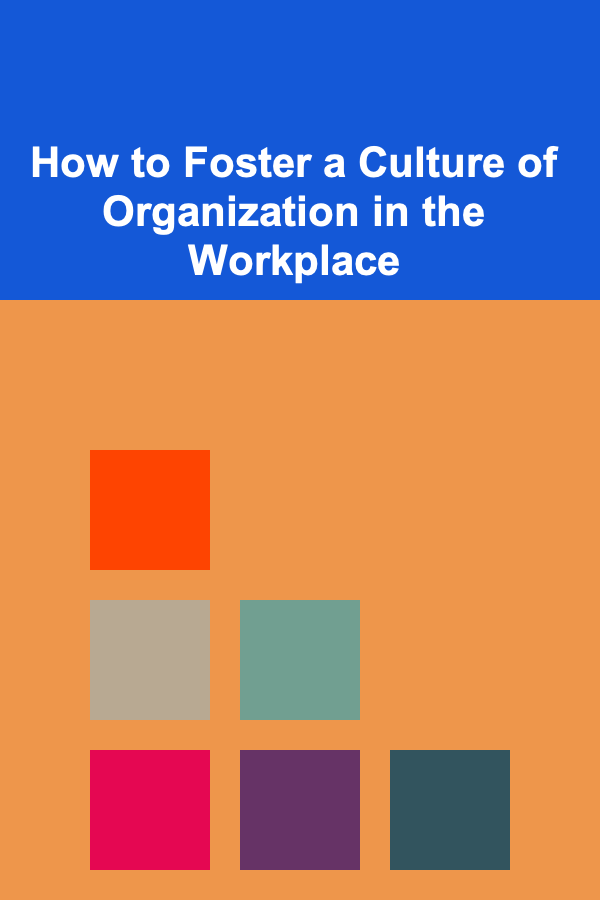
How to Foster a Culture of Organization in the Workplace
ebook include PDF & Audio bundle (Micro Guide)
$12.99$11.99
Limited Time Offer! Order within the next:

In today's fast-paced business environment, fostering a culture of organization within the workplace is more crucial than ever. An organized workplace can lead to increased efficiency, enhanced employee morale, improved communication, and ultimately, better organizational outcomes. This article will explore the various dimensions of cultivating an organized culture in the workplace, including its benefits, strategies for implementation, potential challenges, and real-world examples of successful organizations.
Understanding Organizational Culture
Definition of Organizational Culture
Organizational culture encompasses the values, beliefs, behaviors, and practices that shape the social and psychological environment of a business. It influences how employees interact with one another, make decisions, and approach their work. A strong organizational culture fosters a sense of belonging and purpose, driving employees toward common goals.
Importance of Organization Within Culture
An organized culture emphasizes the importance of structure, clarity, and efficiency in daily operations. It encourages employees to adopt best practices in managing their tasks and responsibilities, leading to improved productivity and job satisfaction. By prioritizing organization, companies can create a supportive environment that nurtures growth and innovation.
Benefits of a Well-Organized Workplace
Increased Efficiency
A well-organized workplace minimizes clutter and distractions, allowing employees to focus on their tasks. Efficient workflows and clearly-defined processes reduce time wastage and enhance overall productivity. Studies have shown that organized environments can lead to a significant increase in output.
Enhanced Communication
Clear organizational structures promote open lines of communication among team members. When everyone understands their roles and responsibilities, it becomes easier to share information, collaborate on projects, and resolve conflicts. Improved communication leads to better teamwork and a more cohesive work environment.
Improved Employee Morale
An organized workplace contributes to a sense of accomplishment and control among employees. When workers feel supported by a structured environment, they are more likely to take pride in their work and remain engaged. High morale translates into lower turnover rates and greater loyalty to the organization.
Greater Innovation
A culture of organization encourages employees to think creatively and propose new ideas. When structures are in place to support innovation, employees are more willing to take risks and experiment. This can lead to groundbreaking solutions and products that drive the company forward.
Strategies to Foster a Culture of Organization
1. Define Clear Goals and Objectives
Establishing clear goals and objectives is the first step towards fostering an organized culture. Organizations should ensure that all employees understand the company's mission and vision. This alignment helps employees prioritize their tasks and stay focused on what matters most.
Action Steps:
- Conduct regular meetings to discuss company goals.
- Use visual aids like posters or digital dashboards to display objectives.
- Encourage departments to set their own measurable goals that align with the overall company vision.
2. Implement Robust Systems and Processes
Creating well-defined systems and processes is essential for maintaining organization. This includes everything from project management tools to standardized procedures for daily tasks. These systems help streamline operations and reduce confusion.
Action Steps:
- Invest in project management software (e.g., Asana, Trello).
- Develop standard operating procedures (SOPs) for routine tasks.
- Regularly review and update processes to ensure they remain effective.
3. Promote Accountability and Ownership
Encouraging accountability ensures that each employee takes ownership of their responsibilities. When individuals know they are accountable for their actions, they are more likely to stay organized and meet deadlines.
Action Steps:
- Implement performance reviews to assess individual contributions.
- Create a culture where employees feel comfortable discussing challenges and seeking help.
- Recognize and reward employees who demonstrate accountability.
4. Provide Training and Resources
Employees need the right tools and training to succeed in an organized environment. Providing resources such as workshops on time management, organizational skills, and stress management can equip employees with essential skills.
Action Steps:
- Offer regular training sessions focusing on organizational skills.
- Provide access to tools that facilitate organization (e.g., calendars, task lists).
- Encourage continuous learning by promoting online courses related to organization and productivity.
5. Lead by Example
Leadership plays a pivotal role in shaping organizational culture. Leaders must model the behaviors they wish to see in their employees. By embodying organizational principles, leaders can inspire their teams to adopt similar practices.
Action Steps:
- Demonstrate effective organization in your own work.
- Share your strategies for staying organized with your team.
- Acknowledge and celebrate organized behaviors in others.
6. Foster a Collaborative Environment
Collaboration is key to maintaining organization across teams. Encouraging teamwork and cross-departmental communication can lead to shared best practices and greater cohesion.
Action Steps:
- Organize team-building activities that emphasize collaboration.
- Create opportunities for interdepartmental projects.
- Establish mentorship programs to encourage knowledge sharing.
7. Utilize Technology Effectively
Incorporating technology can significantly enhance organizational efforts. Tools like cloud storage, collaboration platforms, and data management systems can streamline processes and improve accessibility.
Action Steps:
- Implement cloud-based storage solutions (e.g., Google Drive, Dropbox) for easy access to documents.
- Use collaboration tools (e.g., Slack, Microsoft Teams) to facilitate communication.
- Leverage automation tools to handle repetitive tasks efficiently.
Overcoming Challenges in Fostering Organization
Resistance to Change
One of the primary challenges in implementing an organized culture is resistance to change. Long-standing habits may be difficult to alter, and employees might feel overwhelmed by new processes.
Solutions:
- Communicate the benefits of organization clearly to all employees.
- Involve employees in the change process by soliciting their feedback.
- Provide adequate support and resources during transitions.
Diversity in Work Styles
Different employees may have varying work styles, making a one-size-fits-all approach to organization ineffective. Some individuals thrive in structured environments, while others prefer flexibility.
Solutions:
- Encourage employees to find their own organizational methods that fit within broader company guidelines.
- Offer multiple tools and resources to accommodate diverse preferences.
- Promote a culture of respect for different working styles.
Time Constraints
Organizations often face time constraints that make it challenging to implement new organizational strategies. Employees may feel they do not have the time to engage in training or process improvements.
Solutions:
- Prioritize short, impactful training sessions over lengthy seminars.
- Integrate organization initiatives into existing workflows to minimize disruption.
- Highlight quick wins to demonstrate the value of organization without extensive time commitments.
Real-World Examples
Google: A Model of Organization and Innovation
Google is renowned for its unique organizational culture that emphasizes innovation and collaboration. The company employs a variety of strategies to foster organization, including clear goal-setting through Objectives and Key Results (OKRs), which help employees align their work with the company's broader objectives. Additionally, Google promotes a flexible work environment that allows employees to design their own schedules, catering to diverse work styles while maintaining organizational goals.
Toyota: Lean Manufacturing and Continuous Improvement
Toyota's commitment to organization is exemplified through its Lean Manufacturing philosophy. The company focuses on eliminating waste and optimizing production processes. By instilling a culture of continuous improvement (Kaizen), Toyota empowers employees at all levels to identify inefficiencies and propose organizational enhancements. This has led to significant gains in efficiency and quality.
Zappos: Culture of Empowerment
Zappos, an online retailer, is famous for its customer-centric approach and strong organizational culture. The company fosters organization by empowering employees to make decisions that align with the company's core values. Zappos places a high emphasis on cultural fit during the hiring process, ensuring that new employees resonate with the company's organized and customer-focused ethos.
Conclusion
Fostering a culture of organization in the workplace is a multifaceted endeavor that requires commitment and strategic planning. By defining clear goals, implementing robust systems, promoting accountability, providing training, leading by example, encouraging collaboration, and utilizing technology, organizations can create an environment where employees thrive. Despite the challenges associated with change, the benefits of an organized workplace---such as increased efficiency, enhanced communication, improved morale, and greater innovation---are well worth the effort. As demonstrated by exemplary organizations like Google, Toyota, and Zappos, a strong culture of organization can lead to sustained success and a competitive edge in today's dynamic business landscape.
By investing in organizational culture, businesses can cultivate a thriving workplace that not only meets but exceeds expectations. The journey toward a more organized culture may be gradual, but the rewards are enduring.

How to Build a Custom Pantry Storage System
Read More
How to Incorporate Vintage Lighting into Modern Interiors
Read More
How to Make Money Online as an Occupational Therapist: 10 Actionable Ideas
Read More
How to Use Multi-Tier Shoe Racks for Small Spaces
Read More
How to Utilize Area Rugs for Defining Spaces
Read More
How to Protect Your Voice Data from Smart Speakers
Read MoreOther Products

How to Build a Custom Pantry Storage System
Read More
How to Incorporate Vintage Lighting into Modern Interiors
Read More
How to Make Money Online as an Occupational Therapist: 10 Actionable Ideas
Read More
How to Use Multi-Tier Shoe Racks for Small Spaces
Read More
How to Utilize Area Rugs for Defining Spaces
Read More